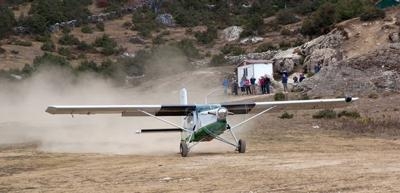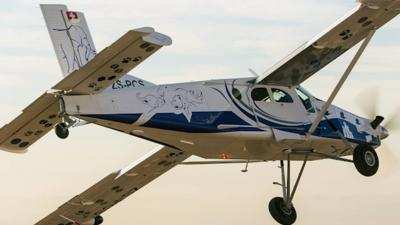Sat, Aug 08, 2020
AD 2020-16-02 Describes The Unsafe Condition As Rudder Shaft Assemblies With Incorrect Rivet Configurations
The FAA is adopting a new airworthiness directive (AD) for Pilatus Aircraft Ltd. Models PC-6, PC-6/350, PC-6/350-H1, PC-6/350-H2, PC-6/A, PC-6/A-H1, PC-6/A-H2, PC-6/B-H2, PC-6/B1-H2, PC-6/B2-H2, PC-6/B2-H4, PC-6/C-H2, PC-6/C1-H2, PC-6-H1, and PC-6-H2 airplanes.

This AD results from mandatory continuing airworthiness information (MCAI) issued by an aviation authority of another country to identify and correct an unsafe condition on an aviation product. The MCAI describes the unsafe condition as rudder shaft assemblies with incorrect rivet configurations. The FAA is issuing this AD to address the unsafe condition on these products. This AD is effective September 9, 2020.
Supplementary Information: The FAA issued a notice of proposed rulemaking (NPRM) to amend 14 CFR part 39 by adding an AD that would apply to Pilatus Aircraft Ltd. Models PC-6, PC-6/350, PC-6/350-H1, PC-6/350-H2, PC-6/A, PC-6/A-H1, PC-6/A-H2, PC-6/B-H2, PC-6/B1-H2, PC-6/B2-H2, PC-6/B2-H4, PC-6/CH2, PC-6/C1-H2, PC-6-H1, and PC-6-H2 airplanes. The NPRM was published in the Federal Register on July 5, 2019 (84 FR 32099). The NPRM proposed to correct an unsafe condition for the specified products and was based on AD No. 2018-0222, dated October 19, 2018, issued by the European Aviation Safety Agency (EASA), which is the Technical Agent for the Member States of the European Community (referred to after this as “the MCAI”).

The MCAI states:
- During a recent check flight with a PC-6, the pilot experienced loss of rudder control. The consequent precautionary landing resulted in a runway excursion and damage to the aeroplane, but without serious injuries to the occupants. The post-event inspection of the affected rudder shaft assembly found an incorrect rivet configuration. Subsequent investigation results identified that the tapered pins had been replaced with an insufficient quantity of rivets of unknown origin, which effectively constituted a modification that does not conform to any of the three different Pilatus-approved configurations. Prompted by this event, five more aeroplanes were inspected and various non-standard rivet configurations were found in the same area. It cannot be excluded that more PC-6 aeroplanes have had a similar modification applied.
- This condition, if not detected and corrected, could lead to failure or loss of rivets, possibly resulting in reduced control of the aeroplane. To address this potential unsafe condition, Pilatus Aircraft Ltd issued the [service bulletin] SB to provide inspection instructions.
- For the reasons described above, this [EASA] AD requires a one-time inspection of the affected part to determine the rivet configuration and, depending on findings, accomplishment of applicable corrective action(s). This [EASA] AD also requires inspection of affected parts held as spare, and depending on findings, corrective action(s), prior to installation.
More News
Also: 787-Billion Pax, Ryanair Buying Chinese, Ballooning HoF, ERAU MX Competition An NTSB Preliminary report is shedding some light on the Rob Holland tragedy. And there now seems>[...]
Also: Tricky Golf Course Deadstick, Textron Special Olympics, Artemis II, FlightSimExpo! Stratolaunch conducted the second successful launch and recovery of its Talon-A2 autonomous>[...]
Also: Rotax Service Instruction, LAA Jabiru Alert, New AMA Boss, FlightSimExpo ANN’s Jim Campbell got an hour in the SLEEK Blackshape Prime last week along with a chance to w>[...]
“Secretary Duffy’s plan cements America as a global leader in aviation, investing in both technology and the air traffic control workforce to enhance U.S. aviation safe>[...]
Witnesses Described That The Glider Pitched Up Before Entering A Nose Low, Left Descending Turn Analysis: The 84-year-old pilot was being towed for takeoff in his glider when the a>[...]
 Airborne 05.05.25: NTSB Holland Prelim, Airlines v Tariffs, $$$ For ATC
Airborne 05.05.25: NTSB Holland Prelim, Airlines v Tariffs, $$$ For ATC Airborne 05.07.25: Talon A-2 Hypersonic, FIFI Under Repair, Spirit Furloughs
Airborne 05.07.25: Talon A-2 Hypersonic, FIFI Under Repair, Spirit Furloughs Airborne Affordable Flyers 05.08.25: Blackshape Test, Risen, Alto NG Sells Out
Airborne Affordable Flyers 05.08.25: Blackshape Test, Risen, Alto NG Sells Out Aero-News: Quote of the Day (05.11.25)
Aero-News: Quote of the Day (05.11.25) NTSB Final Report: Schleicher Alexander GMBH & CO ASH 26 E
NTSB Final Report: Schleicher Alexander GMBH & CO ASH 26 E




